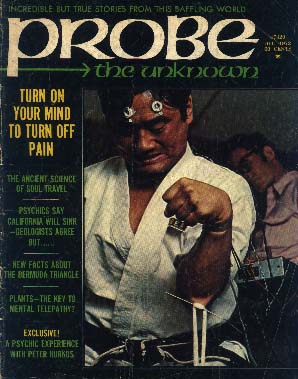

Is the altered state of consciousness achieved
by masters of karate and the other martial arts accompanied by distinct physiological
changes? And is it these changes that enable them to do such extraordinary things
as drive bicycle spokes through their flesh, walk on hot coals, lie on sharpened
swords, and hold molten lead in their mouths without experiencing any pain?
Saturday morning. Nearly two dozen researchers, photographers, and friends were
gathered at the Biofeedback Research Institute with a menagerie of electronic
instruments, cameras, electrodes, and movie lights to find out how Joo Bang
Lee, a 34-year-old Founder of Korean Martial art Hwa Rang Do, was able to drive
a bicycle spoke through the fleshy part of his upper arm without feeling pain.
Mr. Lee had come to the United States from Korea to visit his brother, Joo Sang
Lee, who runs a Hwa Rang Do school in Huntington Park, California, and together
they had agreed to participate in the first of a series of experiments conducted
by the Biofeedback Research Institute (with the help of Black Belt Magazine).
This experiment was designed to study the physiological parameters of a technique
of pain control mastered by the Lee Brothers through the Eastern approach of
Hwa Rang Do. What physiological and/or psychological changes occurred that enabled
Mr. Lee to feel no pain as he was actually driving this spoke through his arm?
Could normal subjects be trained, perhaps, through a Western technique known
as biofeedback, to duplicate these changes and thereby learn a technique for
pain control? 
In general, the concept of biofeedback is premised upon the growing body of
knowledge coming out of research laboritories around the country that a man
is indeed able (as the Eastern traditions have been demonstrating for thousands
of years) to bring under conscious control the functions of the autonomic, or
what up until now has been referred to as the "involuntary" nervous
system. Biofeedback involves the use of electronic instruments which pick up
and amplify physiological functions of the body of which we are not even normally
aware, such as blood pressure and brain waves. These measurements are then translated
into a recognizable signal, such as a light or a tone, and "fed back"
through our conscious sensory system (e.g. our eyes or ears). Somehow, once
a person is made aware of, let's say, his heart rate, he can very easily and
quickly (with repetition and practice) learn to control it.
In research laboratories around the country human volunteers have been trained
to control some autonomic functions such as heart rate, blood pressure, brain
waves, muscle tension, hand temperature and sweat gland activity.
EASING OF PAIN
At the University of Colorado Medical School, for example, two young psychologists,
Dr. Johann Stoyva and Dr. Thomas Budzynski, havd had considerable success in
teaching their patients how to relax specific muscles that tense up and cause
certain kinds of tension headaches. With intensive and serious certain kinds
of tension headaches. With intensive and serious training the easing of pain
has been immediate and impressive.
In Baltimore Dr. Bernard T. Engel, a psychologist, and Dr. Eugene Bleeker, a
cardiovascular specialist, have conducted biofeedback training sessions with
eight patients suffering from premature ventricular contractions (PVC's), a
dangerous irregularity of theheartbeat involving the heart's main pumping chamber.
With exciting success, these patients have learned to speed up, slow down and
narrowly regulate their heart by force of mental discipline alone.
And what about all this furor in the popular press over "alpha waves"
and brain-wave biofeedback? People are learning to produce and regulate certain
brain-wave rhythms as easily as children learn to walk. And just like walking
- or any learning situation - it takes lots of practice and plenty of tumbles.
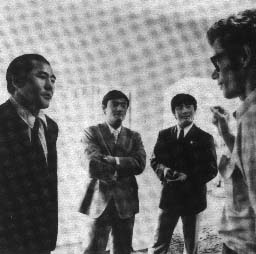
It seems Mr. Lee has learned, through the technique of Hwa Rang Do, a method
for control of pain. Could the technique of biofeedback training be used to
accomplish the same end? If persons could be taught, for example, to prduce
brain waves associated with a relaxed, non-anxious state of mind and at the
same time be taught to overcome and control their "involuntary" anxiety
- their fear of pain - then surely they could at least learn to appreciably
reduce, if not completely eliminate, the "pain" itself.
Hershel Toomim, director of the Los Angeles Biofeedback Research Institute,
and Jeff Stevens, a bright young psychiatrist and clinical director for the
institute, were immediate allies to the project. Toomim began working on a way
to measure a variety of physiological functions on Mr. Lee while he was actually
performing the bicycle-spoke feat. Certainly the body systems that would be
of special interest to watch would include heart rate, bood flow, brainwaves
and muscle response.
It would be easy to measure these functions on someone sitting quietly in classic
lotus posture, softly meditating, but what about on a strapping, young martial
art expert whose warm up meditation involves tremendous muscle tension and ritualistic
movement? The quiet little changes in the autonomic system must be measured
by hypersensitive electrodes. Any movement, even an eyeblink, will throw the
record off by showing what is referred to as "muscle artifact." Muscle
artifact only indicates that there has been movement. It is not an indication
of activity change in the nervous system.
Movement, obviously, could not be eliminated from Mr. Lee's performance. The
best that could be done was to be certain that the electrodes were all securely
anchored, then, in the periods of quiet, hope for the best. Thus, armed with
the most modern,"paste 'em up" methods available - scotch tape, masking
tape and electrode cream - all was ready.
TWO OF THE FEW
Erik Peper, a biofeedback researcher, and Gay Luce, co-authors of the New
York Times Magazine article on biofeedback, "Mind Over Body, Mind Over
Mind," suddenly, after a month-long trip to India, turned up in Los Angeles
the day before the experiment. In 1971 Peper had heard of an Ecuadorian who
practiced unusual control over pain and bleeding. "This man repeatedly
had been hung from hooks inserted under his shoulder blades and had walked through
fire, all without damaging his flesh and with little or no bleeding. He did
not report subjective pain. The opportunity arose to study him and to investigate
the physiological and psychological techniques he used to control pain and bleeding,"
according to Peper in his paper,"Developing a Biofeedback Model: Alpha
EEG Feedback as a means for pain control." If anyone was well equipped
to help with the analysis and interpretation of the results of his experiment,
it was Gay Luce and Erik Peper. 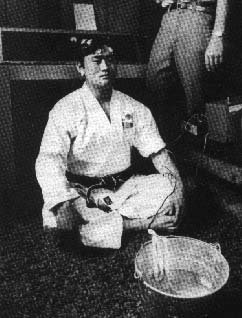
The Lee Brothers, respectfully dressed in grey Western suits and ties, stood
quietly while the electronic tumult went on around them. Joo Bang Lee speaks
no English and his brother, Joo Sang Lee, only enough to order breakfast and
teach his classes. Martial Arts Instructor Mr. Chan-Yong Kim was our translator.
He is a gentle, thoughtful man who took time and effort to translate carefully.
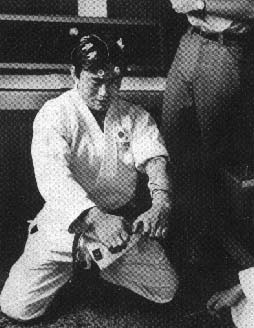
Lights were set and reset. Instruments were shuffled about, tested and retested.
The Lee Brothers changed into their gi (the outfit worn by karate practitioners),
and Joo Bang Lee settled down into classic lotus posture amidst electrodes,
wires and the ironic embranglement of Western technology.
Erik Peper hooked up the five channels to record brain waves. Hershel Toomim
pasted electrodes on Lee's left arm to measure blood flow (did Lee direct the
blood flow away from that arm during penetration to reduce bleeding?). Beryl
Bender attached three electrodes along the same arm to measure what the muscles
in that arm did during the experiment. After a trial run, so that everyone would
have an idea of the movement involved in Mr. Lee's performance, and a strategic
positioning of the photographers, everything was ready for the experiment to
begin.
Mr. Lee performed a ritualistic arm and body movement, went into what seemed
a highly disciplined, well-directed concentration, and threw every muscle in
his body into extreme tension. From what I am able to remember, the EMG (muscle
tension) reading was off-scale, or in excess of 120 microvolts of tension for
the duration of the experiment. We could not put the EMG record through our
print-out EEG - and electroencephalograph hooked up to write down the results
of all our measurements - since all the channels were being used for other measurements.
Therefore, EMG had to be recorded manually.
Lee then yelped his kiai, the cry always heard just before a martial art feat.
His brother, acting as assistant, pulled the flesh of the lower arm away from
the muscle, and Joo Bang Lee stabbed the bicycle spoke through several inches
of skin. At this point, Lee was motionless for several seconds while accurate
physiological measurements were taken.
To further demonstrate his concentration and ability to feel no pain, Lee moved
into a standing position, and a galvanized tin bucket filled nearly full with
water and weighing about 25 pounds was attached to the spoke. Lee lifted the
bucket and held it up for several seconds. Then the bucket was removed, the
spoke taken out, and Lee returned to his lotus, eye-open post-meditation position.
After extricating Joo Bang Lee from the maze of wires and electrodes, the assemblage
returned to the front reception room for an exchange of questions. What had
he experienced? How did he explain what he was able to do? Did he feel any pain?
Any pressure?
Hershel Toomim began explaining,"Tension, muscle artifact, things like
that tend to obscure the other readings. But during the actual penetration the
record is very good. The blood flow record is not clear. Electrode placement
is critical. It must be right over the artery. When he rotated his arm, stretching
the skin a bit, the electrode went off. We tried to tape it in place so that
it would stay, but it didn't make it."
Erik Peper explained that "his eyes-open record (the base-line reading
taken before beginning the feat itself) looks like a normal record. The subject
I had before, during the time that he was actually doing it, was relaxed. His
record was relaxed. In this case, I would almost have to say he (Lee) is doing
an act of focusing - mental focusing; whereas, in the case of my past subject,
he flipped his consciousness. Yes, there was a great deal of alpha present in
the record of my past subject."
Then the questioning came around to Lee himself. According to Kim, the translator
speaking for Lee, the experiment went something like this: "When I am arranging
my body in my preparation, I start my concentration with abdomen power, bringing
the energy up into my arm and letting this energy flow out into the arm. It
is at this point that I insert the spoke...My conmcentrated mind is on the activity
itself; I am not really bothered by my surroundings. I would have to say that
my mind and body are together and then separated from the place where it would
hurt and put somewhere else." Erik Peper explains this seperation as the
disassociation technique: Lee separates his attention from what he is actually
doing. Kim, still talking for Lee, said, "During penetration, I am aware
of what is happening because I am doing it, but I do not feel anything. I don't
even realize that people are around me. No, I do not feel any pressure."
"Where is your focus? Can you explain any further?" Peper questioned.
"Spiritual Ocean"
"Well, it's a pretty complicated matter which involves an understanding
of Oriental philosophy," Kim declared. "The fundamental power is at
the bottom of the abdomen, a space about three inches square, just below the
navel. This is "ki". "In Hwa Rang Do is is called kihae and
corresponds to the ki and chi of other forms of martial art. Literally translated,
it means "spiritual ocean." Once you concentrate on that square,
you can move the energy into any part of the body. The concentrated mind can
be applied to anything he does, and when it is applied, he no longer feels it;
he dosen't exist in the world. So then, it is very much like this "emptying
the mind," or this "point of no consciousness," about which you
have asked. 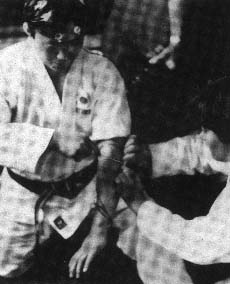
Kim continued, now speaking for Lee again. "My mental direction of energy
is an effort to bring my concentration into a very small area. In other words,
I draw a round circle and then bring that circle into a very small, tiny spot.
The only thing that exists for me is that spot of focused energy and I can then
fit that spot into any particular place."
How then does all this tie in with the brain-wave records taken on Lee and the
results of past experiments? To the biofeedback researcher, who has read most
of the papers that have been written on the physiological effects of various
forms of meditation, the state of meditation seems generally to be accompanied
by a slow, alert, quiet, non-thinking, non-focused type of brain wave rhythm
known as alpha. However, in Lee's case, there was no slow down of brain wave
activity. His record shows a predominance of the of the high frequency, focused
rhythm of normal waking consciousness known as beta. Therefore, it appears that
Lee is not in a state of consciousness similar to a state of meditation as we
know it.
In looking at the "Electroencephalographic Study of Zen Meditation"
conducted by Akiro Kasamatsu and Tomio Hirai of the University of Tokyo in 1966,
the adept practitioners of meditation showed almost continuous alpha waves during
meditation (normally associated with a state of relaxed alertness in ordinary
subjects). This revelation was particulary startling in the case of Zen monks
because their eyes were open. One almost never sees alpha rhythms in the eyes-open
condition of ordinary subjects.
Lee's technique for pain control is obviously different from that of classic
Eastern meditators. Zen masters and yogis, who are able to preform many of the
same feats found in martial arts demonstrations and can walk on hot coals or
puncture the flesh with swords and spokes, employ a technique of deep meditation.
This involves a complete metabolic slowdown, including a predominance of low-frequency
alpha and theta brain waves. They are not focused and are not actively avoiding
the pain. They seem to be "somewhere else."
According to Dr. Jeff Stevens, "I think the most interesting thing about
this experiment is that during the time in which he was sticking the poke in
himself there where little change in any of the measurements that we made. Everything
remained at the same level. It was as if it didn't happen to him. This is significant
from the point of view that it gives a kind of a picture of focusing and would
indicate that the mechanism of his being able to do this was different from...let's
say, the methods of classical meditation. This indicates that perhaps he wasn't
in, let's call it, a "trance," in the standard way that we talk about
"trances." If it was a trance, it was certainly a different kind of
trance.
"In the brain-wave production, for instance...there was no alpha in his
record, no appreciable alpha as he was actually doing it," continued Dr.
Stevens. "There was some alpha earlier in the experiment when he closed
his eyes in his preparatory meditation. Alpha tends to be associated in the
past experiments with a state of being someplace else, of being not there and
not focused.
"Alpha is a non-focused type of brain rythm. It is a normal rythm of the
brain and it appears when you are relaxed. The deeper the relaxation, generally,
the more the alpha...here we didn't see alpha. We did see some slow waves. I
don't know what they mean, but the significance is that he was focused. You
can't get alpha with focusing." 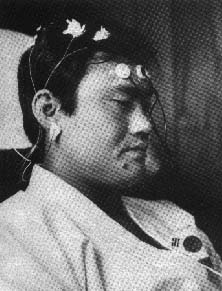
Thus, it appears that the ability to be insensitive to pain is, in this case,
dependent upon Mr. Lee's ability to focus on the Danjun, or "red field,"
the three-inch-square area below the nevel that is the energy source in Hwa
Rang Do. "Red" implies luck, active, genuine, and "field"
implies a cultivated field (as opposed to wild, undisciplined). This "active
discipline" then is condensed to an intense, tiny spot of energy which
is the entire field of cencentration. It is as if there is no room in the conciousness
for the sensation of pain. It is active elimination. It is different from the
passive willing of alpha elimination and biofeedback training. It seems to be
"making it happen" as opposed to "letting it happen," as
is the case in classic meditation. It is a superb concentration in an active
sense. Zen masters and yogis, on the other hand, employ what also seems
to be superb concentration but in a passive sense. There is frequent
reference among the subjects of past similar experiments to "being someplace
else."
Thus of the part of Lee's brain that can be measured, it must be said that it
is "present and focused." But what of the vast regions that still
defy measurements? What of the intricacies and complexities that still seem
light years away from our understanding? The approach of Hwa Rang Do is one
way to teach man to "turn off pain" or, in other words, to cope with
the deleterious effects of the ever-increasing complexities and chaos of modern
technology - one approach to self health. Zen meditation is, obviously another.
Biofeedback, perhaps another. In any case, the key seems to lie in the ability
to become increasingly responsible for one's own condition, to be ever consciously
expanding one's awareness of the self and the self's relationship to the universe.